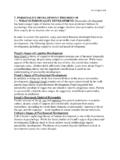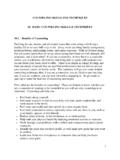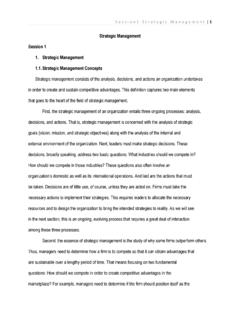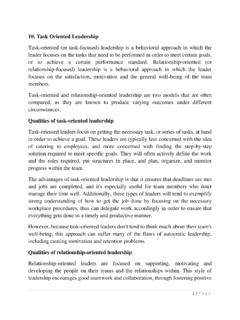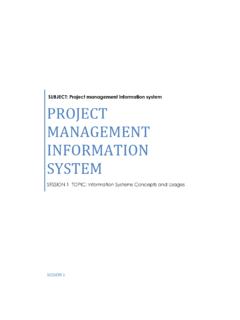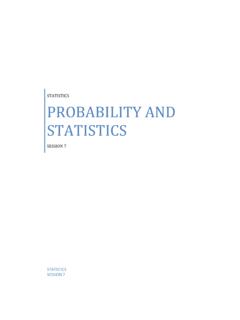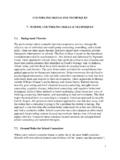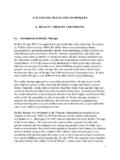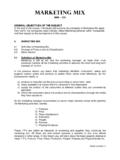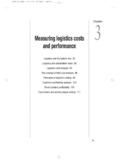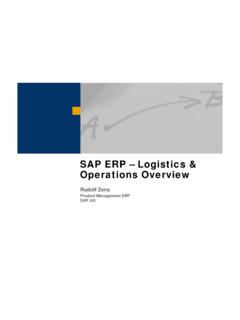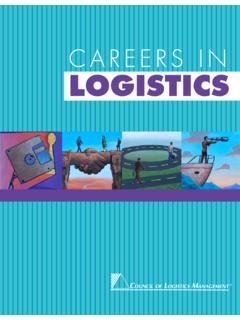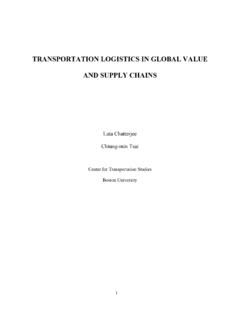Transcription of 1. Logistics - Atlantic International University
1 1. Logistics Logistics is the management of the flow of goods between the point of origin and the point of consumption in order to meet some requirements, for example, of customers or corporations. The resources managed in Logistics can include physical items, such as food, materials, animals, equipment and liquids, as well as abstract items, such as time, information, particles, and energy. The Logistics of physical items usually involves the integration of information flow, material handling, production, packaging, inventory, transportation, warehousing, and often security. The complexity of Logistics can be modeled, analyzed, visualized, and optimized by dedicated simulation software.
2 The minimization of the use of resources is a common motivation in Logistics for import and export. Origins and definition The prevalent view is that term Logistics comes from the late 19th century: from French logistique (loger means to lodge). Others attribute a Greek origin to the word: , meaning reason or speech; , meaning accountant or responsible for counting. The Oxford English Dictionary defines Logistics as "the branch of military science relating to procuring, maintaining and transporting material, personnel and facilities." However, the New Oxford American Dictionary defines Logistics as "the detailed coordination of a complex operation involving many people, facilities, or supplies", and the Oxford Dictionary on-line defines it as "the detailed organization and implementation of a complex operation" Another dictionary definition is "the time-related positioning of resources".
3 As such, Logistics is commonly seen as a branch of engineering that creates "people systems" rather than "machine systems". According to the Council of Logistics Management, Logistics includes the integrated planning, control, realization, and monitoring of all internal and network-wide material, part, and product flow, including the necessary information flow, industrial and trading companies along the complete value-added chain (and product life cycle). for the purpose of conforming to customer requirements. Logistics is the process of planning, implementing, and controlling the effective and efficient flow of goods and services from the point of origin to the point of consumption.
4 1. Academics and practitioners traditionally refer to the terms operations or production management when referring to physical transformations taking place in a single business location (factory, restaurant or even bank clerking) and reserve the term Logistics for activities related to distribution, that is, moving products on the territory. Managing a distribution center is seen, therefore, as pertaining to the realm of Logistics since, while in theory the products made by a factory are ready for consumption they still need to be moved along the distribution network according to some logic, and the distribution center aggregates and process orders coming from different areas of the territory.
5 That being said, from a modeling perspective, there are similarities between operations management and Logistics , and companies sometimes use hybrid professionals, with for ex. "Director of Operations" or " Logistics Officer" working on similar problems. Furthermore, the term supply chain management originally refers to, among other issues, having a global vision of both production and Logistics from point of origin to point of this terms may suffer from semantic change as a side effect of advertising. Logistics viewpoints Inbound Logistics is one of the primary processes of Logistics , concentrating on purchasing and arranging the inbound movement of materials, parts, and/or finished inventory from suppliers to manufacturing or assembly plants, warehouses, or retail stores.
6 Outbound Logistics is the process related to the storage and movement of the final product and the related information flows from the end of the production line to the end user. Logistics fields Given the services performed by logisticians, the main fields of Logistics can be broken down as follows: Procurement Logistics Production Logistics Distribution Logistics After-sales Logistics Disposal Logistics Reverse Logistics 2. Green Logistics Global Logistics Domestics Logistics Concierge Service RAM Logistics Procurement Logistics consists of activities such as market research, requirements planning, make-or-buy decisions, supplier management, ordering, and order controlling.
7 The targets in procurement Logistics might be contradictory: maximizing efficiency by concentrating on core competences, outsourcing while maintaining the autonomy of the company, or minimizing procurement costs while maximizing security within the supply process. Production Logistics connects procurement to distribution Logistics . Its main function is to use available production capacities to produce the products needed in distribution Logistics . Production Logistics activities are related to organizational concepts, layout planning, production planning, and control. Distribution Logistics has, as main tasks, the delivery of the finished products to the customer.
8 It consists of order processing, warehousing, and transportation. Distribution Logistics is necessary because the time, place, and quantity of production differs with the time, place, and quantity of consumption. Disposal Logistics has as its main function to reduce Logistics cost(s) and enhance service(s) related to the disposal of waste produced during the operation of a business. Reverse Logistics denotes all those operations related to the reuse of products and materials. The reverse Logistics process includes the management and the sale of surpluses, as well as products being returned to vendors from buyers. Reverse Logistics stands for all operations related to the reuse of products and materials.
9 It is "the process of planning, implementing, and controlling the efficient, cost effective flow of raw materials, in-process inventory, finished goods and related information from the point of consumption to the point of origin for the purpose of recapturing value or proper disposal. More precisely, reverse Logistics is the process of moving 3. goods from their typical final destination for the purpose of capturing value, or proper disposal. The opposite of reverse Logistics is forward Logistics .". Green Logistics describes all attempts to measure and minimize the ecological impact of Logistics activities. This includes all activities of the forward and reverse flows.
10 This can be achieved through intermodal freight transport, path optimization, vehicle saturation and city Logistics . RAM Logistics (see also Logistic engineering) combines both business Logistics and military Logistics since it is concerned with highly complicated technological systems for which Reliability, Availability and Maintainability are essential, ex: telecommunication systems and military supercomputers. Military Logistics Punjab Regiment uses mules for carrying cargo during WWII. Animals have been used for logistic purposes by different people throughout history, the Roman army in particular preferred mules over donkeys for their carrying capacity.
